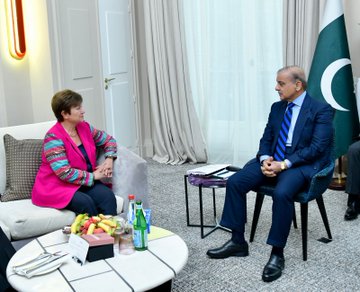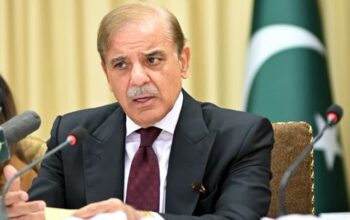By Staff Reporter
ISLAMABAD: Pakistan will implement tax hikes, privatize state assets and overhaul its tax regime to address IMF concerns, as it seeks to plug a $110.5 billion financing gap through 2029, the International Monetary Fund (IMF) documents showed.
The government has committed to drastically reducing the Public Sector Development Programme, ensuring timely tariff adjustments in the gas and electricity sectors, and expanding the tax net to the agriculture and retail sectors.
“The government has committed to drastically reduce the Public Sector Development Programme, ensure timely tariff adjustments in gas and electricity sectors, bring agriculture and retail sectors into effective tax net and immediately impose or increase withholding tax and excise duties on several items to meet any revenue shortfall,” documents on Pakistan’s $7 billion Extended Fund Facility showed.
The IMF staff raised concerns over the establishment of a Sovereign Wealth Fund involving about seven major profitable entities and the creation of the Special Investment Facilitation Council (SIFC).
“Staff has highlighted the need to ensure a level playing field with regard to the investment environment and avoid a watering down in governance standards. These issues remain to be addressed,” the IMF said.
Pakistan has stayed on course with its commitments, achieving 22 structural benchmarks as of September 25. The country requires about $110.5 billion in foreign financing over the next five years (2025 to 2029) at an average of $22 billion per year.
“We commit to ensuring that the SIFC does not propose, nor that the government provide, regulatory, spending, or tax-based incentives of any sort, or any guaranteed returns, or take any other action that could distort the investment landscape,” the government stated.
The government has also promised to amend the 2023 Sovereign Wealth Fund Act by the end of December to ensure that its state-owned enterprises (SOEs) revert to the SOE Act’s governance structures and to ensure that the SWF itself comes under governance mechanisms and safeguards in line with its principal nature as a holding company.
For the next year, the government committed in advance to introduce a 5 percent increase in the FED on fertilizers and pesticides in the FY2026 budget.
Under the National Fiscal Pact with the provinces, the four provinces have committed to amend their agricultural income tax regimes to fully align them, through necessary legislative changes, with federal personal income (small farmers) and corporate income (commercial agriculture) tax regimes by the end of October.
“Each province will begin taxation of agricultural income under this new regime from January 1, 2025, with a collection for the second half of FY25 agricultural income in July 2025.”
The provinces have also agreed to transition the GST on services from a positive list to a negative list approach to combat tax evasion, effective from the start of FY26.
Furthermore, to adequately safeguard against potential fiscal risks, the federal government will allocate emergency contingency funds totaling 0.3 percent of GDP, equivalent to Rs348 billion.
The government aims to increase its tax-to-GDP ratio by 3 percentage points in three years, with a 1.5 percentage point increase already introduced in the current year’s budget worth Rs1.75 trillion.
It committed to increase the tax-to-GDP ratio to 13.7 percent while achieving a primary surplus of 2 percent of GDP by FY28. Some tax rate increases might be unavoidable, the tax policy and administration strategy will focus on bringing in the tax net the undertaxed sectors and bridge the compliance gap.
The government will repeal the remaining exemptions for donations and non-profit organizations in the Second Schedule of the income tax ordinance, making them eligible for tax credits instead.
The FBR will introduce a single turnover-based registration threshold for both income tax and sales tax for a straightforward sales tax system and continue streamlining the GST to ensure a unified reduced rate in the FY26 budget and transform GST into a broad-based value-added tax.
The monetary policy will remain appropriately tight to guide down inflation towards the target alongside continued efforts to improve policy frameworks and strengthen monetary transmission.
The IMF also warned that the economy is vulnerable due to the close ties between the government, central bank and banking sector as the latter holds the world’s largest proportion of government securities relative to its total assets.
“The complex tripartite relationship means that developments or actions in one domain — fiscal, monetary, or banking — can have wide-ranging effects across the economy.”
Banks have funded their growing securities portfolios through short-term central bank liquidity using bonds as collateral, due to limited deposit growth. Persistently high fiscal deficits and external shocks have significant implications for the sovereign-bank nexus.
“Government debt has increasingly been taken up by the banking sector, with banks’ holdings of domestic government debt surging to around 60 percent of their assets,” the IMF said.
The State Bank of Pakistan (SBP) provides liquidity to banks via open market operations (OMOs), which has interconnected the balance sheets of the government, banks and central bank.
“The sovereign’s exposure to high refinancing and interest repricing risks adds to concerns about public debt sustainability,” it added. “The Sovereign-Bank nexus may cause the SBP to face potential trade-offs,” the IMF said.
The IMF reviewed Pakistan’s performance over the past decade, highlighting persistent challenges despite three upper credit tranche arrangements and one Rapid Financing Instrument. Although early progress was often made due to stronger policies under fund-supported programs, this progress was not sustained, leading to the re-emergence of imbalances and the need for successor programs.
To break the cycle of economic boom and bust, Pakistan needs to fundamentally transform its economic policymaking, reduce the state’s role in the economy, strengthen the business environment, attract private investment, and invest in human capital while protecting the most vulnerable.
Fiscal efforts in the FY25 budget and ambitious reforms to broaden the tax base are crucial to strengthening fiscal sustainability. The adoption of the FY25 budget marks an important first step, with high-quality revenue measures targeting general sales tax, personal income tax, and corporate income tax for exporters and developers.
“Pakistani authorities recognize these challenges and have committed to strengthening the country’s resilience and economic prospects. Strong ownership of sound macroeconomic policies and decisive reform implementation is essential.”
IMF said the economic stability is also at risk due to political and social tensions, vested interests and external pressures.
“Political economy considerations and pressures from vested interests could delay or weaken the reform momentum and put at risk still-brittle stability.”
Policy slippages, particularly on revenue measures, could undermine debt sustainability, given Pakistan’s high gross financing needs.
Geopolitical tensions could drive higher commodity prices or tighter global financial conditions, affecting external stability.
The IMF identified major enterprise risks, including business risks, security concerns impacting foreign direct investment and reputational risks.
The country’s economy trails regional peers in living standards.
“Pakistan has been falling behind its peers in recent decades in terms of income per capita, competitiveness, and export performance… living standards have declined relative to peers in South and Southeast Asia, reflecting weak policies, inadequate investment in human and physical capital and state distortions,” the IMF said.
From 2000 to 2022, Pakistan’s GDP per capita grew at an average annual rate of only 1.9 percent, significantly lower than its peers.
“By contrast, Pakistan’s peers achieved more than twice this rate: Bangladesh averaged growth of 4.5 percent, India reached 4.9 percent, Vietnam 5 percent, and China a growth of about 7.5 percent,” the IMF noted.
Copyright © 2021 Independent Pakistan | All rights reserved




